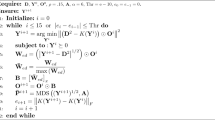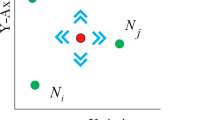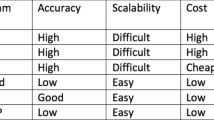Abstract
Triangulation uncertainty is the uncertainty associated when we try to locate an unknown target with the help of three anchor nodes resulting in formation of a triangulated region. Efficient triangulation leads to superior accuracy and lower rate of errors in sensor networks. Although sufficient work has been done to compute localization uncertainties, there is dearth of work pertaining to triangulation uncertainty. The existing problems are: first, localization incurs large computation cost, necessitating some hierarchy or clustering techniques. Second, linear, non-linear and optimization-based solvers invariably simplify the occurrence of errors during estimation of localization. To solve these problems, the present work proposes a range free assistive approach in detecting symmetric triangulations. This approach combined with semidefinite programming of the cost function is shown to exhibit improved localization performance. Numerical results show that the RMS errors is reduced by using triangulation assisted node deployment. The results are compared with the standard weighted least square method for different number of anchor nodes.






Similar content being viewed by others
Abbreviations
- APIT:
-
Approximate point in triangulation
- DV:
-
Distance vector
- SLAM:
-
Simultaneous Localization and mapping
- NLOS:
-
Non-Line of Sight
- GMM:
-
Gaussian Mixture Model
- SDP:
-
Semidefinite programming
- T-LOC:
-
Triangulation Localization
- WLS:
-
Weighted least squares
- MLE:
-
Maximum Likelihood Estimator
- R-O:
-
Radio obstructed link
- nR-O:
-
Unobstructed link
- U:
-
Triangulation Uncertainty
- GMD:
-
Gaussian Mixture distribution
- RMSE:
-
Root mean square error
- RSSr:
-
Received Signal Strength range
- CDF:
-
Cumulative Distribution function
- CRLB:
-
Cramer Rao Lower Bound
- \(N_{a} ,\;N_{na} ,\;N\) :
-
Number of anchor nodes, non-anchor nodes, total number of nodes
- \({\mathbf{x}}_{i} ,\;{\mathbf{x}}_{j}\) :
-
Position of anchor nodes and non-anchor nodes, respectively
- \(\alpha ,\;\beta\) :
-
Pool of anchor nodes, pool of non-anchor nodes
- \(\gamma_{{ii^{\prime}}}\) :
-
Range measurement between \(i^{th}\) and \(i^{\prime}\) pair of nodes
- wii :
-
Additive white Gaussian noise
- \(\sigma_{{ii^{\prime}}}^{2}\) :
-
Variance of \(i^{th}\) and \(i^{\prime}\) pair of nodes
- \(\delta_{{ii^{\prime}}}\) :
-
Range skew between node \(i\) and \(i^{\prime}\)
- \(\angle s_{i} t_{g} s_{{i^{\prime}}}\) :
-
Internal angle of the target vertex node \(t_{g}\)
- \(RSSr\left( {s,t_{g} } \right)\) :
-
Received signal strength range between sensor node \(s\) and target node \(t_{g}\)
- \(U\left( {s_{i} ,{\kern 1pt} s_{{i^{\prime}}} ,{\kern 1pt} {\kern 1pt} t_{g} } \right)\) :
-
Node triangulation uncertainty
- \(\nu_{n}\) :
-
Spatial uncertainty Cluster for \(n^{th}\) target node
- \(n^{th}\) :
-
Number of target node considered
- \(i,i^{\prime},k \in \alpha\) :
-
Anchor nodes
- \(\varepsilon_{U}\) :
-
Positive value
- \(N_{i,k,n}\) :
-
Number (\(N\)) of anchor nodes (subscript \(i\) and \(k\)) responsible for the triangulation of the \(n^{th}\) target node (subscript \(n\))
- Η:
-
Number of links
- \({\mathbf{r}} = \left[ {x^{r} {\kern 1pt} y^{r} } \right]^{T}\) :
-
Common reflection point in case of range obstruction
- \(\left( {t - 1} \right)\) :
-
Time instance during which measurements are taken
- \(\psi_{A}\) :
-
Maximum Likelihood Estimator
- \({\mathbf{\varphi }}\) :
-
Constraint on uncertainty matrix
- \({{\varvec{\upzeta}}}\) :
-
Matrix containing two sets \({{\varvec{\upzeta}}}_{{\mathbf{a}}}\) for anchor nodes and \({{\varvec{\upzeta}}}_{{\mathbf{b}}}\) for non-anchor nodes
- \(\overline{D}_{jm}\) :
-
Upper limit of the uncertainty skew
- \(\Delta \tau_{{ii^{\prime}m}}\) :
-
Upper limit on the absolute difference of uncertainty skew
- \(\rho_{jm} \;and\;g_{jm}\) :
-
Slack variables
- \(M_{jj}^{\left( t \right)}\) :
-
Mobility constraint for \(j^{th}\) node between time instances \(\left( {t - 1} \right)\) and \(t\)
- \(d_{jm}\) :
-
l2-Norm between node \(j\) and node \(m\)
- \(f_{\eta = 0} \left( {\gamma_{jm} ;\hat{d}_{jm} ,H_{1} } \right)\) :
-
Likelihood ratio of no obstruction
- \(f_{\eta > 0} \left( {\gamma_{jm} ;\hat{g}_{jm} ,H_{0} } \right)\) :
-
Likelihood ratio of single or multiple obstructions
- \(eval_{\max }\) :
-
Maximum number of evaluations
- \(Th_{jm}\) :
-
Detection threshold
- \(a\) :
-
Kurtosis factor for skew estimates
- \({{\varvec{\uptheta}}} = \left[ {{\mathbf{l}}^{T} \, {\mathbf{q}}^{T} } \right]^{T}\) :
-
Unknown parameter to be estimated
- \(\Delta {\tilde{\mathbf{\tau }}}\) :
-
Measured location vector of target by non-anchor nodes
- \({{\varvec{\upgamma}}}\) :
-
Measured location vector of target by anchor nodes
- \({\mathbf{J}}_{\theta }\) :
-
Fisher Information matrix (FIM) of unknown parameter \({{\varvec{\uptheta}}}\)
- \({\mathbf{L}}_{1} ,\;{\mathbf{L}}_{2} ,\;{\mathbf{L}}_{3}\) :
-
FIM component for anchor-anchor node link, sensor-anchor node link, and sensor-sensor node link
- \({\mathbf{l}} = \left[ {x_{1}^{T} {\kern 1pt} {\kern 1pt} x_{2}^{T} {\kern 1pt} {\kern 1pt} \ldots x_{{N_{a} }}^{T} } \right]\) :
-
Location vector of anchor nodes
- \({\mathbf{K}}\) :
-
Transformation matrix for triangulation uncertainty skew constraint
References
An V, Qu Z, Crosby F et al (2020) A triangulation-based coverage path planning. IEEE Trans Syst Man, Cybern Syst 50:2157–2169. https://doi.org/10.1109/TSMC.2018.2806840
Chen H, Shi Q, Huang P et al (2009) Mobile anchor assisted node localization for wireless sensor networks. IEEE Int Symp Pers Indoor Mob Radio Commun PIMRC. https://doi.org/10.1109/PIMRC.2009.5449959
Chen H, Ballal T, Saeed N et al (2020) A joint TDOA-PDOA localization approach using particle swarm optimization. IEEE Wirel Commun Lett 9:1240–1244. https://doi.org/10.1109/LWC.2020.2986756
Chen YS, Chang SH, Teng CC (2014) Location estimation based on convex overlapping communication regions in wireless ad hoc sensor networks. 2014 4th Int Conf Wirel Commun Veh Technol Inf Theory Aerosp Electron Syst VITAE 2014 - Co-located with Glob Wirel Summit. https://doi.org/10.1109/VITAE.2014.6934471
Darakeh F, Mohammad-Khani GR, Azmi P (2017) An accurate distributed rage free localization algorithm for WSN. 2017 25th Iran Conf Electr Eng ICEE 2017 2014–2019. https://doi.org/10.1109/IRANIANCEE.2017.7985388
Gong Z, Li C, Jiang F (2018) AUV-aided joint localization and time synchronization for underwater acoustic sensor networks. IEEE Signal Process Lett 25:477–481. https://doi.org/10.1109/LSP.2018.2799699
Gopikrishnan S, Mahendiran PD, Jothiprakash V (2016) Localization of sensor nodes in the presence of obstruction in wireless sensor network environment. Proc 10th Int Conf Intell Syst Control ISCO 2016. https://doi.org/10.1109/ISCO.2016.7727144
Hsieh YL (2006) Wang K (2006) Efficient localization in mobile wireless sensor networks. Proc - IEEE Int Conf Sens Net Ubiqu Trust Comput II:292–296. https://doi.org/10.1109/SUTC.2006.1636189
Jyothi R, Babu P (2020) SOLVIT: a reference-free source localization technique using majorization minimization. IEEE/ACM Trans Audio Speech Lang Process 28:2661–2673. https://doi.org/10.1109/TASLP.2020.3021500
Kubo T, Tagami A, Hasegawa T et al (2012) Range-free localization using grid graph extraction. Proc - Int Conf Netw Protoc ICNP. https://doi.org/10.1109/ICNP.2012.6459988
Lee J, Choi B, Kim E (2013) Novel range-free localization based on multidimensional support vector regression trained in the primal space. IEEE Trans Neural Networks Learn Syst 24:1099–1113. https://doi.org/10.1109/TNNLS.2013.2250996
Li Y, Ma S, Yang G, Wong K-K (2020) Robust localization for mixed LOS/NLOS environments with anchor uncertainties. IEEE Trans Commun 6778:1–1. https://doi.org/10.1109/tcomm.2020.2982633
Ma M, Yang Y (2007) Adaptive triangular deployment algorithm for unattended mobile sensor networks. IEEE Trans Comput 56:946–947. https://doi.org/10.1109/TC.2007.1054
Mekonnen ZW, Wittneben A (2014) Robust TOA based localization for wireless sensor networks with anchor position uncertainties. In: 2014 IEEE 25th Annual international symposium on personal, indoor, and mobile radio communication (PIMRC). IEEE, pp 2029–2033
Prateek AR (2021a) C-TOL: Convex triangulation for optimal node localization with weighted uncertainties. Phys Commun 46:101300. https://doi.org/10.1016/j.phycom.2021.101300
Prateek AR (2021b) Range free localization technique under erroneous estimation in wireless sensor networks. J Supercomput. https://doi.org/10.1007/s11227-021-04075-x
Prateek AR, Verma AK (2021) Non-coherent localization with geometric topology of wireless sensor network under target and anchor node perturbations. Wirel Networks 27:2271–2286. https://doi.org/10.1007/s11276-021-02575-5
Saeed N, Celik A, Alouini M-S, Al-Naffouri TY (2020) Analysis of 3D localization in underwater optical wireless networks with uncertain anchor positions. Sci China Inf Sci 63:202305. https://doi.org/10.1007/s11432-019-2758-2
Sahin A, Eroglu YS, Guvenc I et al (2015) Hybrid 3-D Localization for Visible Light Communication Systems. J Light Technol 33:4589–4599. https://doi.org/10.1109/JLT.2015.2477502
Salari S, Shahbazpanahi S, Ozdemir K (2013) Mobility-aided wireless sensor network localization via semidefinite programming. IEEE Trans Wirel Commun 12:5966–5978. https://doi.org/10.1109/TWC.2013.110813.120379
Seguel F, Krommenacker N, Charpentier P, et al (2018) Convex polygon positioning for homogeneous optical wireless networks. IPIN 2018 - 9th Int Conf Indoor Position Indoor Navig. https://doi.org/10.1109/IPIN.2018.8533863
Shen Y, Wymeersch H, Win MZ (2010) Fundamental limits of wideband localization - Part II: Cooperative networks. IEEE Trans Inf Theory 56:4981–5000. https://doi.org/10.1109/TIT.2010.2059720
Shi Q, He C (2008) A SDP approach for range-free localization in wireless sensor networks. IEEE Int Conf Commun. https://doi.org/10.1109/ICC.2008.791
Shi Q, He C, Chen H, Jiang L (2010) Distributed wireless sensor network localization via sequential greedy optimization algorithm. IEEE Trans Signal Process 58:3328–3340. https://doi.org/10.1109/TSP.2010.2045416
Sortais M, Hermann SD (2008) Analytical investigation of intersection based range-free localization. Ann Telecommun - Ann Des Télécommunications 635(63):307–320. https://doi.org/10.1007/S12243-008-0030-9
Stupp G, Sidi M (2004) The Expected Uncertainty of Range Free Localization Protocols in Sensor Networks. Lecture Notes in Computer Science (including subseries Lecture Notes in Artificial Intelligence and Lecture Notes in Bioinformatics). Springer, pp 85–97
Yang K, Fang W, Zhao Y, Deng N (2019) Iteratively Reweighted Midpoint Method for Fast Multiple View Triangulation. IEEE Robot Autom Lett 4:708–715. https://doi.org/10.1109/LRA.2019.2893022
Zeng F, Yu M, Zou C, Gong J (2012) An improved point-in-triangulation localization algorithm based on cosine theorem. 2012 Int Conf Wirel Commun Netw Mob Comput WiCOM 2012. https://doi.org/10.1109/WICOM.2012.6478419
Zhang T, Qin C, Molisch AF, Zhang Q (2016) Joint allocation of spectral and power resources for non-cooperative wireless localization networks. IEEE Trans Commun 64:3733–3745. https://doi.org/10.1109/TCOMM.2016.2580149
Zhang TN, Mao XP, Zhao CL, Long XZ (2019) Optimal and fast sensor geometry design method for TDOA localisation systems with placement constraints. IET Signal Process 13:708–717. https://doi.org/10.1049/iet-spr.2018.5171
Author information
Authors and Affiliations
Corresponding author
Additional information
Publisher's Note
Springer Nature remains neutral with regard to jurisdictional claims in published maps and institutional affiliations.
Appendix A
Rights and permissions
About this article
Cite this article
Prateek, Arya, R. T-LOC: RSSI-based, range-free, triangulation assisted localization for convex relaxation with limited node range under uncertainty skew constraint. J Ambient Intell Human Comput 14, 7063–7077 (2023). https://doi.org/10.1007/s12652-021-03559-1
Received:
Accepted:
Published:
Issue Date:
DOI: https://doi.org/10.1007/s12652-021-03559-1




